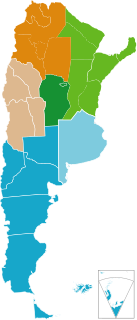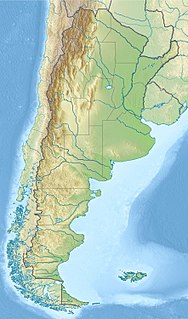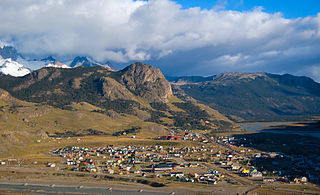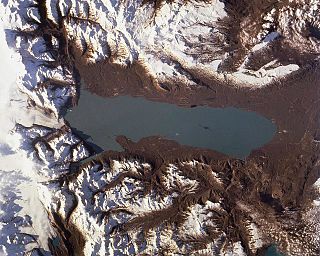
Patagonia is a sparsely populated region at the southern end of South America, shared by Argentina and Chile. The region comprises the southern section of the Andes Mountains, lakes, fjords, and glaciers in the west and deserts, tablelands and steppes to the east. Patagonia is bounded by the Pacific Ocean on the west, the Atlantic Ocean to the east, and many bodies of water that connect them, such as the Strait of Magellan, the Beagle Channel, and the Drake Passage to the south.

Argentina is provided with a vast territory and a huge variety of climates and microclimates ranging from tundra and polar in the south to the tropical climate in the north, through a vast expanse of temperate climate and natural wonders like the Aconcagua, the highest mountain in the world outside the Himalayas, the widest river and estuary of the planet, the huge and mighty Iguazú Falls, some of the flattest and wide meadows-plains of planet Earth, culture, customs and cuisines famous internationally, a higher degree of development, good quality of life and people and relatively well prepared infrastructure make this country one of the most visited in South America.

Santa Cruz Province is a province of Argentina, located in the southern part of the country, in Patagonia. It borders Chubut Province to the north, and Chile to the west and south, with an Atlantic coast on its east. Santa Cruz is the second-largest province of the country, and the least densely populated in mainland Argentina.

Los Glaciares National Park is a federal protected area in Santa Cruz Province, Argentina.

The Perito Moreno Glacier is a glacier located in the Los Glaciares National Park in southwest Santa Cruz Province, Argentina. It is one of the most important tourist attractions in the Argentinian Patagonia.

Viedma is a subglacial volcano whose existence is questionable. It is supposedly located below the ice of the Southern Patagonian Ice Field, an area disputed between Argentina and Chile. The 1988 eruption deposited ash and pumice on the ice field and produced a mudflow that reached Viedma Lake. The exact position of the edifice is unclear, both owing to the ice cover and because the candidate position, the "Viedma Nunatak", does not clearly appear to be of volcanic nature.

The Patagonian Ice Sheet was a large elongated and narrow ice sheet centered in the southern Andes that existed during the Llanquihue glaciation. The ice sheet covered all of Chile south of Puerto Montt plus the western fringes of Argentine Patagonia.

Monte Fitz Roy is a mountain in Patagonia, on the border between Argentina and Chile. It is located in the Southern Patagonian Ice Field, near El Chaltén village and Viedma lake. It was first climbed in 1952 by French alpinists Lionel Terray and Guido Magnone.

El Chaltén is a small mountain village in Santa Cruz Province, Argentina. It is located on the riverside of Rio de las Vueltas, within the Los Glaciares National Park near the base of Cerro Torre and Cerro Fitz Roy spires, both popular for climbing. It is 220 km north of El Calafate. It is also a popular base for hiking numerous trails, such as those to the base of surrounding peaks and glacial lakes, such as Laguna Torre and Laguna de los Tres.

Viedma Lake, approximately 50 miles long in southern Patagonia near the border between Chile and Argentina. It's a major elongated trough lake formed from melting glacial ice. Viedma Lake is the second largest lake in Argentina.

The Northern Patagonian Ice Field, located in southern Chile, is the smaller of two remnant parts in which the Patagonian Ice Sheet in the Andes Mountains of lower South America can be divided. It is completely contained within the boundaries of Laguna San Rafael National Park.

El Calafate is a city in Patagonia, Argentina. It is situated on the southern border of Lake Argentino, in the southwest part of the Santa Cruz Province, about 320 kilometres (200 mi) northwest of Río Gallegos. The name of the city is derived from a little bush with yellow flowers and dark blue berries that is very common in Patagonia: the calafate ; the word comes from the word calafate, which is Spanish for 'caulk'.

The lake known as O'Higgins in Chile and San Martín in Argentina is located around coordinates 48°50′S72°36′W in Patagonia, between the Aysén del General Carlos Ibáñez del Campo Region and the Santa Cruz Province.

The Southern Patagonian Ice Field, located at the Southern Patagonic Andes between Chile and Argentina, is the world's second largest contiguous extrapolar ice field. It is the bigger of two remnant parts of the Patagonian Ice Sheet, which covered all of southern Chile during the last glacial period, locally called the Llanquihue glaciation.

The Aónikenk people, also referred to by the exonym Tehuelche, are an indigenous people from Patagonia in South America, with existing members of the group currently residing in the southern Argentina-Chile borders.

Dickson Lake is a glacier lake in southern Patagonia located in the Southern Patagonian Ice Field, which since 1998 has been transformed into an international lake as it is crossed by the international boundary between Argentina and Chile due to the retreat of the Dickson glacier. Until that year, Dickson Lake was entirely within Chilean territory, at the northern end of the Torres del Paine National Park in the Magallanes y la Antártica Chilena Region, but it was unified with a lake that began to form in the 1980s by defrosting the melting of the Dickson, Cubo and Frías glaciers. That lake was on the Argentine side when the Agreement was signed to specify the route of the limit from Mount Fitz Roy to the Daudet Hill of 1998, in a sector adjacent to the Los Glaciares National Park, but without being part of it. The lake is fed by the glacier that shares its name and is drained by the Paine River. It receives the waters of Los Perros River, which starts at a proglacial lake that was formed during the retreat of Los Perros Glacier.

Reclus, also written as Reclús, is a volcano located in the Southern Patagonia Ice Field, Chile. Part of the Austral Volcanic Zone of the Andes, its summit rises 1,000 metres (3,300 ft) above sea level and is capped by a crater about 1 kilometre (0.62 mi) wide. Close to the volcano lies the Amalia Glacier, which is actively eroding Reclus.

Viedma Glacier is a large glacier that is part of the huge Southern Patagonian Ice Field, located at the southern end of mainland South America. Viedma Glacier is a valley glacier and its moraine-rich terminus flows into the western end of Lake Viedma, which is fed primarily by its melting ice. Viedma Glacier is located in the undefined part of the limit between Chile and Argentina, in argentinian legislature it's in Los Glaciares National Park which was declared a World Heritage Site in 1981. in Chilean legislature part of it is in Bernardo O'Higgins National Park. The Southern Patagonian Ice Field is 13,000 square kilometres (5,000 sq mi); Viedma Glacier is one of the Ice Field's 48 outlet glaciers that have more than 20 square kilometres (7.7 sq mi) of ice field area each.

The Del Desierto lake or Lake of the Desert is a lake, located in the Lago Argentino Department, Santa Cruz Province, Argentina. The lake, located near the mount Fitz Roy and the O'Higgins/San Martín Lake, has been the subject of a territorial dispute between Argentina and Chile, escalating to a small battle on 6 November 1965 when 40 to 90 members of the Argentine Gendarmerie fought against four Chilean Carabineros resulting the lieutenant Hernán Merino killed and a sergeant injured, both members of Carabineros, the dispute was solved favourably for Argentina in 1994 with an arbitration.

The last glacial period and its associated glaciation is known in southern Chile as the Llanquihue glaciation. Its type area lies west of Llanquihue Lake where various drifts or end moraine systems belonging to the last glacial period have been identified. The glaciation is the last episode of existence of the Patagonian Ice Sheet.






















